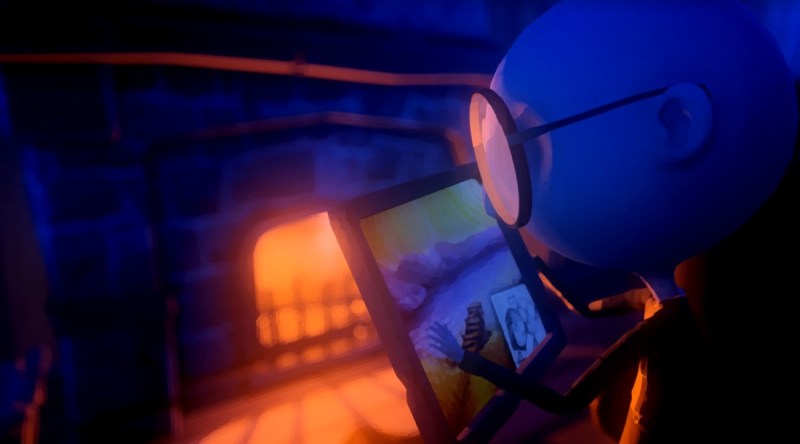Massimi Guarini, creative director at Italy’s Studio Osovonico, has an intriguing idea for a game. A couple is in love in Last Day of June, a video game coming soon from 505 Games. The couple gets in an accident, and one of them dies. Your job as the player is to relive that last day — June is the name of the character who dies — and change it so that the accident doesn’t happen. It’s going to be an emotional journey, and one that you may play over and over again.
I recently sat down with Guarini, an acclaimed director who previously worked on titles such as Murasaki Baby, Shadow of the Damned, Naruto: Rise of a Ninja. He told me he was inspired by the film Groundhog Day, a Bill Murray comedy where he relives one day over and over again until he gets the ending right. The idea is the same in Last Day of June, where the smallest of decisions can have a Butterfly Effect and impact the fatal accident.
Guarini said, “The game asks players to ask themselves, ‘What would you do to save the one you love?'”
That’s a sad subject for a video game, and it contrasts with the beautiful 3D cartoon art style.
June 5th: The AI Audit in NYC
Join us next week in NYC to engage with top executive leaders, delving into strategies for auditing AI models to ensure fairness, optimal performance, and ethical compliance across diverse organizations. Secure your attendance for this exclusive invite-only event.
Guarini’s studio worked with award-winning musician Steven Wilson and writer/director Jess Cope, animator on Frankenweenie, and director of Metallica’s Here Comes Revenge music video. 505 Games will publish the title sometime this year on the PlayStation 4 and on Steam on the PC.
Here’s an edited transcript of our interview.

Above: Massimo Guarini, creative director at Studio Osovonico, maker of Last Day of June.
GamesBeat: Did you start from this Groundhog Day-type mechanic or another part of the story?
Massimi Guarini: It was more about the emotion of the game. From that idea, starting with a theme that’s so familiar for all of us — if you think about finding yourself in a situation where you’re losing somebody you really care about, somebody you love, I thought it would be really interesting to develop a short story around that. The player would be able to act as the center of this experience, not just passively take in the story as something being told to them. The point was to make something where, through gameplay, you can experience those strong emotions and build up this journey through loss. That’s what we hope to do with this game.
GamesBeat: It brings to mind the notion of the butterfly effect. After something happens, you always think back on what you could have done to change it.
Guarini: Exactly. That’s part of the payoff. The butterfly effect is definitely something that has a big input into the game. As you can see from what we’ve shown of the game, such mundane little actions can have grave consequences in your life. The point is, can you do something about this? That’s the real question.

Above: Carl, the protagonist of Last Day of June is bound to a wheel chair after an accident.
GamesBeat: There doesn’t seem to be an obvious way to make a mistake here. What exactly are you trying to change?
Guarini: That’s up to the player. They have the chance to relive the day before the accident and try to understand what went wrong, what can be changed, and if that might cause other events. Of course, as we’ve seen in stories about the butterfly effect, if you change one little thing to avoid one outcome, you might cause something else. It’s going to be up to the player to experience how the facts unfold and how to change different things.
GamesBeat: How difficult is it going to be to change the past?
Guarini: It’s not that difficult, insofar as you’ll have choices, and you’ll be able to interact in different ways with the environment and other characters. It’ll be a combination of different events that lead to a certain outcome. Changing a single event might be easy to understand, but the puzzle elements and the nature of the game will lead you to deal with things as a combination of events.

Above: Last Day of June
GamesBeat: Would you say that it’s fair to the player?
Guarini: That’s an interesting question. [laughs] I could answer that by asking you, is life fair? Is life unfair? Probably both of those things are true. It depends on how you live the experience yourself. I want to leave that interpretation up to the player.
GamesBeat: It reminds me a little of Until Dawn, too. In some ways there were very consequential moral choices you could make in that game, but then there were accidents, things that almost felt like a coin toss. Go left and die, go right and live.
Guarini: It’s not quite that much of a binary situation. As I said before, it’s more like putting things together that eventually lead to something. We didn’t want to have very clear, simple left-right choices, but rather a combination of choices that create a result. I’d say it’s more like playing chess with your fate.
GamesBeat: And the game mechanics are important to this. It’s not just a movie you watch. You have to play with it.
Guarini: Right. You have to play and live through these events with the characters. They play a role. The important part for us is that you’re the actor. You’re actively doing things — pressing buttons, walking around, moving objects. That’s the important thing. Linear narration allows a certain amount of freedom for us, but the important thing here is that the player is the puppeteer of the whole universe, of the intertwining situation. That’s the interesting part. The main characters themselves are a narrative tool for us.
GamesBeat: How did you wind up choosing these particular characters?
Guarini: There are several characters in the game, and you’ll discover how they all may have had a role in causing the crash. As to how and when, that’ll be one of the surprises we want to keep under wraps.

Above: Carl is in a sad state after the accident in Last Day of June.
GamesBeat: You chose what seems like an un-game-like setting, out in this relaxing countryside.
Guarini: It becomes increasingly emotionally challenging. What you’ve seen so far presents the beginning of the story, and the atmosphere at that point is very relaxed, to set up the prologue that leads into the main titles. A darker side starts creeping in as you play the game and see what the characters are doing. You find more and more dots and connect them all together to reveal the thread behind all this. It’s a journey. The emotional path is like a roller coaster. We can’t give away too much, because it would ruin the experience.
GamesBeat: And it all takes place within this one day that you play over and over again?
Guarini: Right. It’s within that time range: some hours before the crash, during the crash, and right afterward. That’s the day, the last day of June.
https://www.youtube.com/watch?v=xmdORg04D_E


